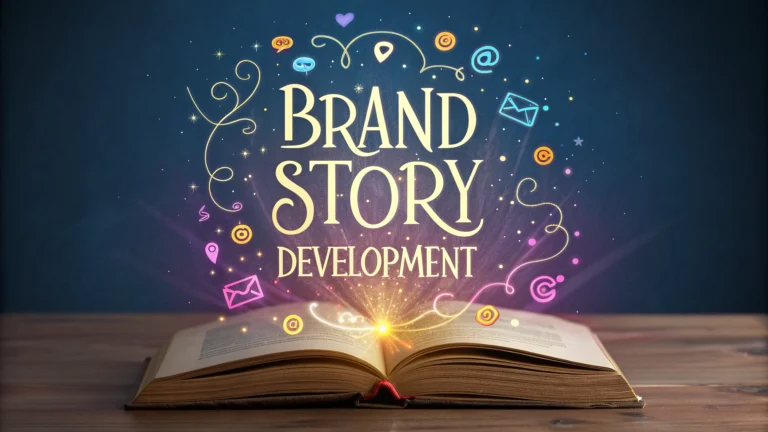A brand story connects your business with customers through authentic, memorable narratives that showcase your values, mission, and unique market position.
Your brand story needs three core elements: a compelling origin, clear values, and an emotional connection with your audience.
Elements of an Effective Brand Story
- Authentic background and founding story
- Mission and core values
- Customer pain points and solutions
- Brand personality and voice
- Visual identity elements
Logo Design Integration
Your logo design should visually represent key elements from your brand story through thoughtful color choices, typography, and imagery.
Quick Tips for Logo-Story Alignment
- Select colors that reflect your brand emotions and values
- Choose fonts that match your brand personality
- Use symbols that connect to your origin story
- Keep designs simple enough to be memorable
Writing Your Brand Story
Start with these questions:
- Why did you start your business?
- What problem does your product/service solve?
- How are you different from competitors?
- What impact do you want to make?
Common Brand Story Mistakes to Avoid
- Making the story too complex
- Focusing only on product features
- Using industry jargon
- Copying competitor narratives
- Neglecting emotional connection
Implementation Strategy
- Document your core story elements
- Create brand voice guidelines
- Design visual identity systems
- Train team members on story delivery
- Test story reception with target audience
Professional brand consultants can help develop your story – find certified experts through the American Marketing Association directory.
Measuring Brand Story Success
- Customer feedback and surveys
- Social media engagement rates
- Brand recognition metrics
- Customer loyalty indicators
- Sales conversion rates
Update your brand story annually to reflect company growth, market changes, and evolving customer needs.
Implementing Your Brand Story
Content Distribution Channels
- Website “About Us” page
- Social media profiles
- Marketing materials
- Employee training documents
- Sales presentations
Story Evolution Timeline
Set key milestones for reviewing and updating your brand story:
- Quarterly reviews of messaging effectiveness
- Semi-annual content audits
- Annual comprehensive story updates
- Major pivot points during company growth
Building Customer Connections
Storytelling Techniques
- Use customer testimonials and case studies
- Share behind-the-scenes content
- Highlight team member stories
- Document community involvement
- Showcase product development journey
Customer Engagement Strategies
- Interactive social media campaigns
- User-generated content initiatives
- Brand ambassador programs
- Community events and workshops
Conclusion
A well-crafted brand story creates lasting connections with customers and differentiates your business in the marketplace. Regular updates, consistent messaging across channels, and authentic storytelling will strengthen your brand’s market position and customer relationships.
Next Steps
- Review your current brand narrative
- Identify areas for story enhancement
- Develop implementation timeline
- Begin measuring story impact
FAQs
- What’s the difference between brand story development and brand storytelling?
Brand story development is the strategic process of creating your core brand narrative, including your origin, values, and purpose. Brand storytelling is the ongoing act of communicating that story through various channels and content. - How do brand story and logo design work together?
Your brand story informs logo design by providing crucial context about your values, personality, and mission. The logo becomes a visual representation of your brand story, using colors, shapes, and typography that align with your narrative. - What are the essential elements of a strong brand story?
A strong brand story includes your company’s origin, core values, mission statement, unique value proposition, target audience understanding, brand personality, and emotional connection points. - How long should the brand story development process take?
The brand story development process typically takes 4-8 weeks, including research, stakeholder interviews, story framework development, refinement, and final documentation. - What research is needed for brand story development?
Research should include competitor analysis, target audience insights, market positioning studies, historical company data, customer feedback, and industry trends. - Should my logo design come before or after brand story development?
Brand story development should precede logo design, as your story provides the strategic foundation that informs visual design choices, ensuring alignment between narrative and visual identity. - How do I ensure my brand story is authentic?
Authenticity comes from basing your story on true company values, actual experiences, genuine mission statements, and real customer relationships rather than fabricated or aspirational elements. - What role does the target audience play in brand story development?
Target audience understanding is crucial as your brand story must resonate with their values, address their pain points, and connect with their aspirations to be effective. - How does brand story affect logo redesign projects?
When redesigning a logo, the brand story guides decisions about which heritage elements to retain, what to modernize, and how to evolve the visual identity while maintaining brand consistency. - What makes a brand story memorable?
Memorable brand stories combine emotional appeal, clear purpose, unique positioning, relatable elements, authentic values, and consistent messaging across all touchpoints.







